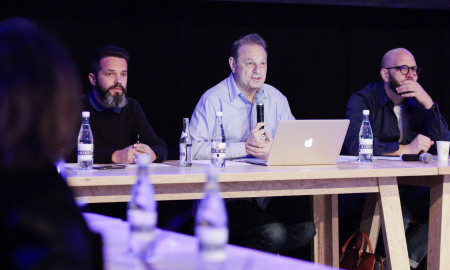
How Will the Denim Industry Tackle Its Waste Problem?
Waste in the denim industry has been gaining more attention with collections like G-Star’s Raw for the Oceans and jeans drives from brands like J. Crew and Gap. Waste was also the topic of Kingpins Transformers in Amsterdam in April. Carved in Blue talked further with some of the panelists, who are leading industry experts, about the obstacles blocking sustainability in denim.
Andrew Olah, Kingpins founder, pointed out that the denim industry creates a tremendous amount of waste, including a significant amount of synthetics, which never degrade.
Miguel Sanchez, head of global business development, segment denim and casualwear at Archroma, pointed out that waste is generated at every step along the denim manufacturing line, beginning with fiber lint and continuing, more significantly, into chemical waste and suspended solids.
“We need to understand that in manufacturing anything, there is waste, and once we understand that, we can figure out how to avoid the waste or recycle it,” Olah said.
One of the barriers to the general understanding of waste is that waste and pollution are generated far away from the consumers, Michael Kininmonth, project manager at Lenzing, pointed out.
Kininmonth continued, “Thus these potential decision-makers have little knowledge of the ecological and social impacts of the wastes associated with denim jeans they purchase, so they have little incentive or ability as consumers to change their habits based on waste considerations.“
Steps have been taken to counteract the waste. Lenzing has worked on turning by-products of fiber manufacturing into useful items, such as acetic acid for the food and industrial industries. Similarly, Archroma uses redundant biomass as the raw material for the manufacturing of non-oil based dyes and chemicals.
Sanchez said, “There are plenty of things that can be done right away. It is just required that denim brands and retailers definitively make a move to adopt the resource and waste saving technologies.”
Kininmonth said that creative thinking is taking place in all steps of the supply chain now. Most notably, in washing, which used to be a very secretive part of the manufacturing process and now is arguably the sector doing the most to improve its environmental footprint.
He went on to say, however, that though there are lots of ideas generated by the denim supply chain, there is mistrust when it comes to sharing them. “Co-operation between different parts of the supply chain have to improve to accelerate waste reduction, and brands and retailers can be the catalyst for this kind of collaboration,” Kininmonth said.






